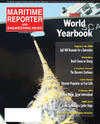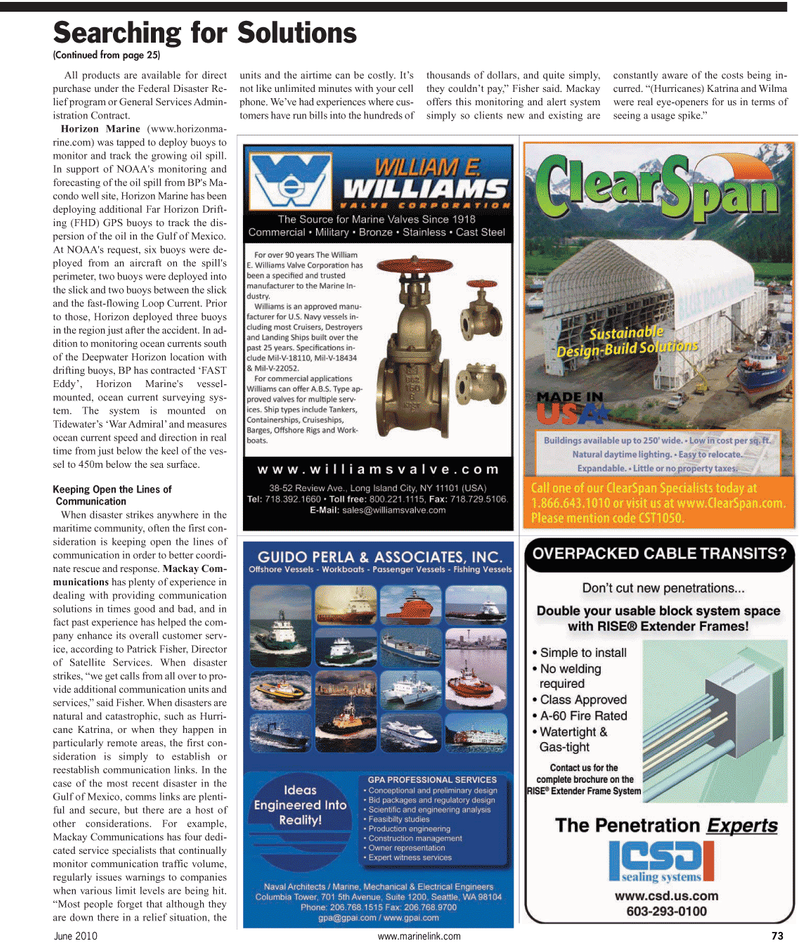
Page 73: of Maritime Reporter Magazine (June 2, 2010)
Read this page in Pdf, Flash or Html5 edition of June 2, 2010 Maritime Reporter Magazine
All products are available for direct purchase under the Federal Disaster Re- lief program or General Services Admin- istration Contract.
Horizon Marine (www.horizonma- rine.com) was tapped to deploy buoys to monitor and track the growing oil spill.
In support of NOAA's monitoring and forecasting of the oil spill from BP's Ma- condo well site, Horizon Marine has been deploying additional Far Horizon Drift- ing (FHD) GPS buoys to track the dis- persion of the oil in the Gulf of Mexico.
At NOAA's request, six buoys were de- ployed from an aircraft on the spill's perimeter, two buoys were deployed into the slick and two buoys between the slick and the fast-flowing Loop Current. Prior to those, Horizon deployed three buoys in the region just after the accident. In ad- dition to monitoring ocean currents south of the Deepwater Horizon location with drifting buoys, BP has contracted ‘FAST
Eddy’, Horizon Marine's vessel- mounted, ocean current surveying sys- tem. The system is mounted on
Tidewater’s ‘War Admiral’ and measures ocean current speed and direction in real time from just below the keel of the ves- sel to 450m below the sea surface.
Keeping Open the Lines of
Communication
When disaster strikes anywhere in the maritime community, often the first con- sideration is keeping open the lines of communication in order to better coordi- nate rescue and response. Mackay Com- munications has plenty of experience in dealing with providing communication solutions in times good and bad, and in fact past experience has helped the com- pany enhance its overall customer serv- ice, according to Patrick Fisher, Director of Satellite Services. When disaster strikes, “we get calls from all over to pro- vide additional communication units and services,” said Fisher. When disasters are natural and catastrophic, such as Hurri- cane Katrina, or when they happen in particularly remote areas, the first con- sideration is simply to establish or reestablish communication links. In the case of the most recent disaster in the
Gulf of Mexico, comms links are plenti- ful and secure, but there are a host of other considerations. For example,
Mackay Communications has four dedi- cated service specialists that continually monitor communication traffic volume, regularly issues warnings to companies when various limit levels are being hit. “Most people forget that although they are down there in a relief situation, the units and the airtime can be costly. It’s not like unlimited minutes with your cell phone. We’ve had experiences where cus- tomers have run bills into the hundreds of thousands of dollars, and quite simply, they couldn’t pay,” Fisher said. Mackay offers this monitoring and alert system simply so clients new and existing are constantly aware of the costs being in- curred. “(Hurricanes) Katrina and Wilma were real eye-openers for us in terms of seeing a usage spike.”
June 2010 www.marinelink.com 73 (Continued from page 25)
Searching for Solutions

 72
72

 74
74
